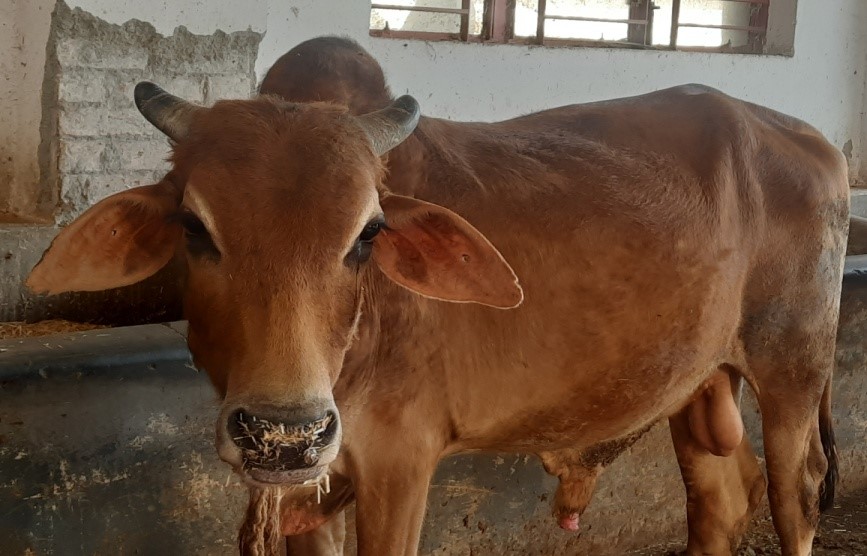Effect of Heat Stress on Animal Health and Production
Dr Ankit Sharma1 , Dr Monika Karnani2 , Dr Shweta Sharma3 , Dr Ramesh Verma4
Post Graduate Institute of Veterinary Education and Research, Jaipur
Rajasthan University of Veterinary and Animal Sciences, Bikaner, Rajasthan, India
anksagour588@gmail.com 8209937273
Climate change is considered as very sensitive topic now a days and considered to be one of the most serious threats to sustainable development. According to the Intergovernmental Panel on Climate Change, the earth’s temperature has been rising by 0.2°C every ten years. It was also anticipated that by 2100, the average global surface temperature will rise to 1.4-5.8°C.
When the body’s physiological processes fail to keep the body temperature within a normal range, it results in heat stress, a kind of hyperthermia. Dairy cows that are nursing can activate their stress response systems when the ambient temperature rises over 35°C. Heat stress (HS) is a complicated phenomenon that causes a number of animal response mechanisms that have a detrimental effect on the welfare and productivity of cattle.
Animal development, milk production, wool production, and reproduction are all adversely impacted by heat stress. Growth, the production of meat, milk, and eggs, reproductive function, imbalanced biochemical and physiological processes of metabolism, and immune response are all negatively impacted by a rise in ambient temperature.
Animal’s body capacity to dissipate heat through sweating and panting is significantly decreased if the temperature surpasses 24-26 °C for exotic and cross breed animals, 33 °C for native cows, and 36 °C for buffaloes. As a result, the body’s temperature rises dramatically.
Animals that are exposed to high heat loads may change how often they lie down and how much time they spend sitting and standing, whether they eat or drink, how aggressive or afraid they are, and how loud they are.
Feed intake begins to fall in nursing cows at an ambient temperature of 25-26 °C and declines substantially at temperatures over 30 °C. Dietary consumption can be decreased by up to 40% at 40 °C. High temperatures cause a considerable rise in body surface evaporation, as well as an increase in water consumption and a reduction in faecal water.
Rumination time is shortened and hunger is decreased by a rise in ambient temperature. Bacteria that produce methane are also impacted by heat stress.
Via cellular and fluid immunological reactions, heat stress also has a detrimental impact on the immune system. As a result, the animal is more susceptible to illness and immunological problems when its immune system is suppressed. By preventing rumination, heat stress can also weaken the immune system, increasing the likelihood that illness will strike dairy cattle. Under heat stress, cows are more prone to developing mastitis.
Heat stress has been shown to have an impact on several physiological processes, including estrus length, colostrum quality, conception rate, uterine function, endocrine status, follicular growth and development, luteolytic processes, early embryonic development, and foetal growth. Seasonally, male endocrine profiles and fertility are also impacted.
Heat stress can alter the rumen’s function, the udder’s health, and the feeding pattern, which eventually reduces milk supply. The additional loss of milk production in 2020 will be 1.6 million tonnes owing to the increase in thermal stress throughout the day brought on by the temperature increase. Animals that are exposed to temperatures exceeding 35°C may experience thermal stress, which reduces their feed intake and eventually impacts milk production. Up to 600 or 900 kg of milk per cow each lactation might be lost due to heat stress.
Heat stress not only reduces milk production, but it can also alter the milk’s composition. In dairy cows, heat stress decreased milk protein, milk fat, and solids-not-fat (SNF).
The endocrine system of a cow can go entirely out of balance while under heat stress. Prolactin, thyroid hormones, glucocorticoids, growth hormone, adrenocorticotropic hormone (ACTH), oxytocin, oestrogen, and progesterone are just a few of the hormone profiles that might vary as a result of heat stress.
Proper breeding management, cooling system in the shed, feeding management, drinking plenty of clean and cool water, providing electrolytes can reduce the negative effects of heat stress.
References
Das, R., Sailo, L., Verma, N., Bharti, P., Saikia, J., Imtiwati, K.R. and Kumar, R., 2016. Impact of heat stress on health and performance of dairy animals: A review. Veterinary world, 9(3), pp.260-268.
Farooq, U., H.A. Samad, F. Shehzad and A. Qayyum, 2010. Physiological responses of cattle to heat stress. World Applied Sci. J., 8: 38-43.
Beede, D.K. and R.J. Collier, 1986. Potential nutritional strategies for intensively managed cattle during thermal stress. J. Anim. Sci., 62: 543-554.
Das, R., Sailo, L., Verma, N., Bharti, P., Saikia, J., Imtiwati, K.R. and Kumar, R., 2016. Impact of heat stress on health and performance of dairy animals: A review. Veterinary world, 9(3), pp.260-268.
Pragna, P., Archana, P.R., Aleena, J., Sejian, V., Krishnan, G., Bagath, M., Manimaran, A., Beena, V., Kurien, E.K., Varma, G. and Bhatta, R., 2017. Heat stress and dairy cow: impact on both milk yield and composition.
Jordan, E.R., 2003. Effects of heat stress on reproduction. Journal of Dairy Science, 86, pp.E104-E114.
Purwanto, B.P., Abo, Y., Sakamoto, R., Furumoto, F. and Yamamoto, S., 1990. Diurnal patterns of heat production and heart rate under thermoneutral conditions in Holstein Friesian cows differing in milk production. The Journal of Agricultural Science, 114(2), pp.139-142.
Bagath, M., Krishnan, G., Devaraj, C., Rashamol, V.P., Pragna, P., Lees, A.M. and Sejian, V., 2019. The impact of heat stress on the immune system in dairy cattle: A review. Research in veterinary science, 126, pp.94-102.
Aggarwal, A. and R. Upadhyay, 2013. Heat Stress and Animal Productivity. Springer, New York, USA., ISBN: 9788132208792, Pages: 188.



